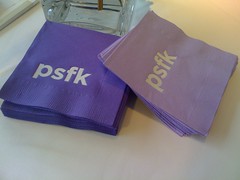 photo by Sami NiemeläIn addition to SWAT Summit, I had the pleasure of attending one of PSFK's conferences in San Francisco this past week. PSFK is known for trend insights and bringing together unique and intelligent people from a variety of disciplines.After a brief introduction by PSFK founder Piers Fawkes, Ed Cotton (BSSP) talked about why you should care about trends. Ed stated that trends are just stuff, from guerilla gardeners to cupcakes. Super-saturated society is not a new concept and inspiration for trends can come from anywhere, whether it be an RSS feed or a flower. The presentation talked about other "not new" concepts like how consumers own a brand and not the brand itself. This old concept got me thinking about the web 2.0 landscape and how social networks quite possibly are a smidge behind brands in learning this lesson. Many social networks/services/apps are still struggling with the idea that the community owns the service and not the service itself (a statement for a separate post that I intend to write more at length about).Next on the agenda was San Francisco Snapshot with Colin Nagy (Attention), Amit Gupta (Photojojo), Jeremy Townsend (Ghetto Gourmet), Kevin Allison (Financial Times) and Liz Dunn (Funny Or Die). After living in San Francisco for almost a year now and loving it, this was a great session for me to sit in on. San Francisco is fairly unique - despite being geographically smaller, it tends to hold its own internationally. The panel discussed how the time shift of the Pacific Time Zone from the rest of the world (e.g. we wake up later and are the last ones to go to sleep in the U.S.) allows for innovation. Someone in the audience asked about how SF residents come off as very smug about everything and I really enjoyed Liz Dunn's answer. Liz smiled and said (I'm quoting from memory), "well, it's like LA has the celebrities and New York has the financial power, and we (SF) are like the nerds saying "well, I didn't want to hang out with them anyway!". Our celebrities in SF are like Steve Jobs, a nerd, and I think that says a lot about who we are".The rest of the conference featured more brilliant minds and inspiring talks. Andrew Hoppin (NASA) and Ezra Cooperstein (Current TV) discussed how they engage and collaborate with individuals and communities from around the world. Gareth Kay (Modernista), Eric Corey Freed (Organic Architect), Frank Striefler (Media Arts Lab) and Josh Morenstein (fuseproject) gave examples of how to make inspiration matter. One of the most notable examples was an architect asking about the menstrual behaviors of a client - the client confessed that she wanted a wall that was three feet in front of the toilet because when she experienced cramps growing up, she would put her feet on the wall in front of her. By taking the time to learn such intimate details about the client, the architect was able to design a house that truly worked on a custom level.Listening to so many positive examples and people was inspiring and comforting to know that many are dedicated to making positive changes across the world on a one-by-one basis.
photo by Sami NiemeläIn addition to SWAT Summit, I had the pleasure of attending one of PSFK's conferences in San Francisco this past week. PSFK is known for trend insights and bringing together unique and intelligent people from a variety of disciplines.After a brief introduction by PSFK founder Piers Fawkes, Ed Cotton (BSSP) talked about why you should care about trends. Ed stated that trends are just stuff, from guerilla gardeners to cupcakes. Super-saturated society is not a new concept and inspiration for trends can come from anywhere, whether it be an RSS feed or a flower. The presentation talked about other "not new" concepts like how consumers own a brand and not the brand itself. This old concept got me thinking about the web 2.0 landscape and how social networks quite possibly are a smidge behind brands in learning this lesson. Many social networks/services/apps are still struggling with the idea that the community owns the service and not the service itself (a statement for a separate post that I intend to write more at length about).Next on the agenda was San Francisco Snapshot with Colin Nagy (Attention), Amit Gupta (Photojojo), Jeremy Townsend (Ghetto Gourmet), Kevin Allison (Financial Times) and Liz Dunn (Funny Or Die). After living in San Francisco for almost a year now and loving it, this was a great session for me to sit in on. San Francisco is fairly unique - despite being geographically smaller, it tends to hold its own internationally. The panel discussed how the time shift of the Pacific Time Zone from the rest of the world (e.g. we wake up later and are the last ones to go to sleep in the U.S.) allows for innovation. Someone in the audience asked about how SF residents come off as very smug about everything and I really enjoyed Liz Dunn's answer. Liz smiled and said (I'm quoting from memory), "well, it's like LA has the celebrities and New York has the financial power, and we (SF) are like the nerds saying "well, I didn't want to hang out with them anyway!". Our celebrities in SF are like Steve Jobs, a nerd, and I think that says a lot about who we are".The rest of the conference featured more brilliant minds and inspiring talks. Andrew Hoppin (NASA) and Ezra Cooperstein (Current TV) discussed how they engage and collaborate with individuals and communities from around the world. Gareth Kay (Modernista), Eric Corey Freed (Organic Architect), Frank Striefler (Media Arts Lab) and Josh Morenstein (fuseproject) gave examples of how to make inspiration matter. One of the most notable examples was an architect asking about the menstrual behaviors of a client - the client confessed that she wanted a wall that was three feet in front of the toilet because when she experienced cramps growing up, she would put her feet on the wall in front of her. By taking the time to learn such intimate details about the client, the architect was able to design a house that truly worked on a custom level.Listening to so many positive examples and people was inspiring and comforting to know that many are dedicated to making positive changes across the world on a one-by-one basis.
SWAT Summit: Advertising in social networks
 The first ever SWAT Summit kicked off this last week in San Francisco. The aim of the conference was to help advertisers effectively enter and work with social networks.Due to unfortunate scheduling, I was only able to make it for the last half of the one-day event (earlier in the day I was attending PSFK's conference). My friend and colleague, Steve Hall of Adrants, had the honor of speaking at two sessions, one of which was The Science of Measuring Campaign Success (User Metrics and Engagement). The session included Ian Swanson (Sometrics), Kim Kochaver (Federated Media), Troy Young (VideoEgg), and Anna Banks (McCann Worldgroup). Steve grilled everyone on if the case studies they were presenting actually worked at the end of the day, and it was obvious that some of the panelists were agitated by this question.The panelists discussed how demographic targeting/analyzing tools in Facebook were making it easier for clients and ad agencies to measure success in social media. I couldn't help but raise my hand and ask if this was actually considered progress. By these standards, it seems like advertising is making little to no progress by taking the same solution (demographics, impressions, etc.) and trying to force-fit it into a new problem (social media). I've been ranting for a while that demographics are dead. It seems like advertisers are taking the easy way out by using traditional metrics and refusing to spend effort towards educating clients about what is relevant in social media. Additionally, I never once heard the panel mention the idea of building custom metrics based on social media analysis and relevance to the individual project.I think it's important for conferences like SWAT Summit to talk about these issues, but I wish there was more representation from the social media side (for the half of the day I was there, it seemed very advertiser-heavy).
The first ever SWAT Summit kicked off this last week in San Francisco. The aim of the conference was to help advertisers effectively enter and work with social networks.Due to unfortunate scheduling, I was only able to make it for the last half of the one-day event (earlier in the day I was attending PSFK's conference). My friend and colleague, Steve Hall of Adrants, had the honor of speaking at two sessions, one of which was The Science of Measuring Campaign Success (User Metrics and Engagement). The session included Ian Swanson (Sometrics), Kim Kochaver (Federated Media), Troy Young (VideoEgg), and Anna Banks (McCann Worldgroup). Steve grilled everyone on if the case studies they were presenting actually worked at the end of the day, and it was obvious that some of the panelists were agitated by this question.The panelists discussed how demographic targeting/analyzing tools in Facebook were making it easier for clients and ad agencies to measure success in social media. I couldn't help but raise my hand and ask if this was actually considered progress. By these standards, it seems like advertising is making little to no progress by taking the same solution (demographics, impressions, etc.) and trying to force-fit it into a new problem (social media). I've been ranting for a while that demographics are dead. It seems like advertisers are taking the easy way out by using traditional metrics and refusing to spend effort towards educating clients about what is relevant in social media. Additionally, I never once heard the panel mention the idea of building custom metrics based on social media analysis and relevance to the individual project.I think it's important for conferences like SWAT Summit to talk about these issues, but I wish there was more representation from the social media side (for the half of the day I was there, it seemed very advertiser-heavy).
CupcakeCamp comes to San Francisco this Sunday!
 (artwork by Cindy Li)The first ever CupcakeCamp (inspired by BarCamp and the constant cupcake gatherings in New York) is coming to San Francisco this Sunday! CupcakeCamp was created by Cindy Li, Lynn, Marianne Masculino and myself with support from the cupcake-loving community.To RSVP to CupcakeCamp, go here. We also have a wiki here.Cupcakes Take The Cake recently interviewed me about CupcakeCamp and my personal cupcake views.Can't wait!
(artwork by Cindy Li)The first ever CupcakeCamp (inspired by BarCamp and the constant cupcake gatherings in New York) is coming to San Francisco this Sunday! CupcakeCamp was created by Cindy Li, Lynn, Marianne Masculino and myself with support from the cupcake-loving community.To RSVP to CupcakeCamp, go here. We also have a wiki here.Cupcakes Take The Cake recently interviewed me about CupcakeCamp and my personal cupcake views.Can't wait!
Covert Operation
I've been digging through a lot of my old work this past week and stumbled across a pitch that was a lot of fun to execute. In 2005/2006, my former agency VML received a RFP from Ubisoft to create buzz for their upcoming release of Splinter Cell 4. I had directed a very large brainstorming session for creating various concepts for the pitch. With an incredibly creative and talented team, we came up with some awesomely insane guerrilla ideas to pitch, but we wanted to somehow prove to Ubisoft that we were able to not only create these ideas, but to actually execute them as well. My favorite projects have always been the ones that I've been involved with from creation to execution, and part of the reason I really enjoyed working at VML for so long was to be able to do random things like this.The night before the pitch, Adam Kellogg, Aaron Weidner, and myself flew in to San Francisco and acquired a generator, a $60k projector, and a minivan. The result is this video. Adam edited the video overnight and we presented it the next morning in the pitch (note: this was never meant to be a viral video). At the end of the video, we turned to Ubisoft and said "now, imagine if that was the NSA building" - their jaws dropped. Needless to say, most of our ideas required a budget for bail.